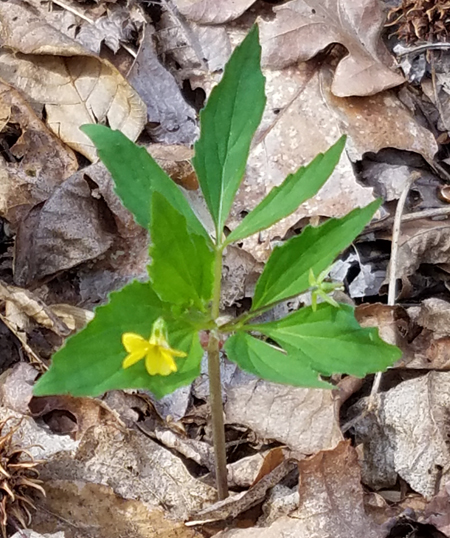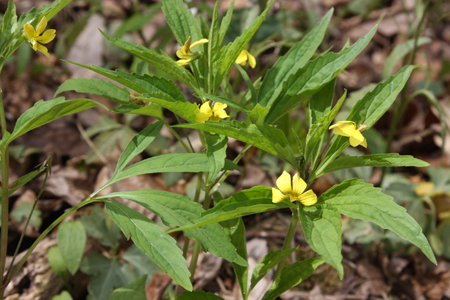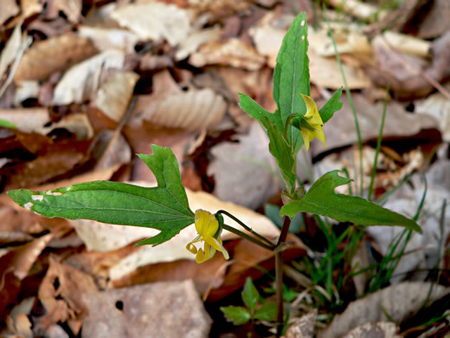Viola tripartita Elliott
Common names:
Three-parted Yellow Violet
Synonyms:
Viola tripartita Elliott, Sketch bot. S. Carolina 1(3): 302. 1817; Viola hastata Michx. var. tripartita (Elliott) A.Gray, Bot. Gaz. 11(11): 291. 1886. TYPE: [USA], Georg.[ia], Athens, [no date], W. Green [s.n.] (HOLOTYPE: CHARL-BY4773!, internet image!).
Description:
Caulescent perennials from thick rhizome, stems erect, solitary, ≤ 36 cm tall; stems, foliage and peduncles green or gray- to olive-green, stems, petioles and lower surface of leaf blades sometimes purple-tinged, glabrous, hirtellous or hirsute; leaves cauline (occasionally 1 basal), spreading, leaves mostly well distributed along the stem; stipules free, entire, weakly erose or moderately incised; leaves spreading, smallest upper leaf blades undivided, larger lower deeply tripartite (rarely merely shallowly lobed), largest ≤ 103 × 100 mm, upper in outline deltate-lanceolate to narrowly deltate-ovate, lower narrowly to broadly deltate or deltate-ovate to broadly ovate-triangular, base narrowly cuneate to broadly rounded or subtruncate, margins entire or weakly (rarely prominently) serrate, teeth usually restricted to proximal half, eciliate or appressed-ciliate, apex acute to acuminate; chasmogamous flower ≤ 10 mm; calyx glabrous or pubescent, eciliate or ciliate; lowest sepals lanceolate, acute; auricles short and entire, not elongating in fruit; corolla wholly yellow with purple-black lines at base of petals and purple- or brown-tinged on back of petals; spur short-globose; lateral petals densely bearded with slightly clavate hairs, spurred petal glabrous; cleistogamous flowers produced after chasmogamous; capsule (7)8–11 mm, green drying brown, unspotted, glabrous or tomentose; seeds 2.5–2.8 × 1.5–2.0 mm, tan to light brown, unspotted.
Similar species:
None. This species is distinctive.
Ecology:
Rich sandy loam soils in dry-mesic or mesic forests, probably associated with mafic rocks (Weakley 2015). In the relatively rare sites where the present species occurs sympatrically with V. glaberrima or V. tenuipes, this species typically grows near the ridgetops or on the upper slope. At other sites, in the s. Appalachian Mountains, it often grows at the bottom of the slope near streams.
Distribution:
Centered in the s. Appalachian Mountains; w. NC to se. TN, south to n. GA, disjunct (and presumed extirpated) in s. OH.
Rarity:
State listed in OH.
Phenology:
Chasmogamous flower March–June, chasmogamous fruit April–July, cleistogamous fruit July–September.
Affinities:
This species belongs to the Yellow Violet lineage, sect. Chamaemelanium Ging., in the Nudicaules species group.
Hybrids:
None.
Comments:
Elliott's protologue stated that the species was known "From specimens collected near Athens, Georgia, by Mr. Green. Flowers March–April." Elliott did not designate a type, did not indicate a single collection or specify a herbarium. However, according to Stafleu and Cowan (1976), Elliott's herbarium is at the Charleston Museum. A thorough search of the Elliott collection at CHARL revealed a single specimen, which matches the protologue information. It is accepted here as the holotype.
Brainerd (1921b), Russell (1965), Lévesque and Dansereau (1966), Gleason and Cronquist (1991), McKinney and Russell (2002), and Little and McKinney (2015) synonymized V. glaberrima under the present species as a mere leaf morph. Fernald (1950) maintained the two as formas under V. tripartita; while Alexander (1963), Brainerd Baird (1942), Ballard (2000), and Weakley et al. (2012) recognized them as varieties. In all cases, V. tenuipes Pollard has been ignored, being implicitly included in V. glaberrima however the latter was treated. Details supporting segregation of predominately northern V. glaberrima (Ging.) House and southern V. tenuipes Pollard) as distinct evolutionary species are provided under those species. Rare shallowly lobed plants, evidently forming small populations in a few localities in Georgia and Tennessee in the range of V. tripartita, are not hybrids since they lack intermediate features and are otherwise identical to typical V. tripartita elsewhere in the immediate area; they appear to be a product of arrested leaf division. The typical leaf dissection pattern in this species results in some three-lobed or occasionally five-lobed leaf blades, with the uppermost blades often undivided. The present species is one of the rarest violets in our region, now extirpated from sites on the northern periphery of its historical range and uncommon over most of its southern distribution.
Literature Cited:
Alexander, E. J. 1963. Violaceae. In Gleason, H. A., The new Britton and Brown illustrated flora of the northeastern United States and adjacent Canada. Hafner Publishing Co., Inc., New York, NY. 552-567.
Ballard Jr., H. E. 2000. Violaceae. In Rhoads, A. (ed.). Flora of Pennsylvania. University of Pennsylvania Press, Philadelphia, PA. 700-710.
Brainerd, E. 1921b. Violets of North America. Vermont Agricultural Experiment Station Bulletin 224: 1-172.
Brainerd Baird, V. 1942. Wild violets of North America. University of California Press, Berkeley, CA.
Fernald, M. L. 1950. Violaceae. In Gray’s Manual of Botany, 8th ed. American Book Company, New York, NY. 1022-1042.
Gleason, H. A., and A. Cronquist. 1991. Violaceae. In Manual of vascular plants of northeastern United States and adjacent Canada, 2nd ed. New York Botanical Garden, Bronx, NY. 157-163.
Lévesque, L., and P. Dansereau. 1966. Études sur les violettes jaunes caulescentes de l’Est de l’Amerique du Nord. I. Taxonomic, nomenclature, synonymie et bibliographie. Naturaliste Canadien (Quebec) 93: 489-569.
Little, R. J., and L. E. McKinney. 2015. Violaceae. In Flora of North America: Cucurbitaceae to Droseraceae, 106. Oxford University Press, New York, NY.
McKinney, L. E., and N. H. Russell. 2002. Violaceae of the southeastern United States. Castanea 67: 369-379.
Russell, N. H. 1965. Violets (Viola) of the central and eastern United States: An introductory survey. Sida 2: 1-113.
Stafleu, F.A., & R.S. Cowan. 1976. Taxonomic literature: a selective guide to botanical publications and collections with dates, commentaries and types, 2nd ed., vol. 1: A-G. Bohn, Scheltema & Holkema, Utrecht, The Netherlands. [https://www.sil.si.edu/DigitalCollections/tl-2/]
Strausbaugh, P. D., and E. L. Core. 1978. Violaceae. In Flora of West Virginia, 2nd ed. Seneca Books, Inc., Morgantown, WV. 644-658.
Weakley, A. S., J. C. Ludwig, and J. F. Townsend. 2012. Violaceae. In Flora of Virginia. BRIT Press, Fort Worth, TX. 963-975.

Chasmogamous flowering habit (plant at GA, Clarke Co., State Botanical Garden of Georgia, 26 Match 2017) by Harvey Ballard

Chasmogamous flowering habit by Bruce Sorrie

Leaves during chasmogamous flower by Bruce Sorrie

Leaves of "partially lobed" morph during chasmogamous flower by Richard and Teresa Ware, "Native & Naturalized Plants of the Carolinas & Georgia" website

Chasmogamous flower profile view (plant at SC, Pickens Co., Keowee-Toxaway State Natural Area, April) by J. K. Marlow, "Native & Naturalized Plants of the Carolinas & Georgia" website
